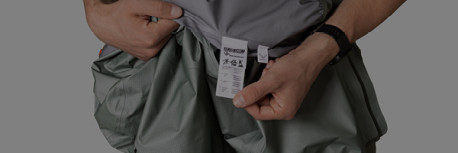Microplastics: Mountain endurance sports and responsibility
Mountain endurance sports means having powerful experiences in alpine surroundings: The taste of fresh powder, the feeling after a long mountain run, or the smell of the wind on the summit -- people, experiences and nature’s outdoor world are the focus of attention. We support mountain endurance athletes along the way with innovative products. The highly technical materials used for apparel often consist of synthetics for optimum comfort during intense physical activity. Mechanical abrasion during washing technical apparel however results in microplastics that are increasingly a cause for environmental pollution. We take very seriously building a bridge between fabrics used for best possible performance during use and environmental consciousness!
How are microplastics created?
Microplastics are small synthetic particles, up to 5mm, that contaminate waters as well as the soil. Microfibers, a type of microplastic found in synthetic fabrics such as polyester and nylon, have the same effect. Every time you wash a hardshell jacket, ski touring pant, or running shirt made of synthetic technical fibers, microfibers are created that with mechanical abrasion then creates minute plastic fibers. One single piece of apparel can release more than 1,500 fibers every time it is washed. The microplastics created then flow with the wastewater into the sewer system and then onward into the planet’s waters since wastewater treatment plants can only filter out a fraction of them.
Performance vs. environmental pollution
If you are active, you sweat. Technical fabrics facilitate the wicking of moisture during ski touring or alpine running. In addition, technical fibers dry significantly faster. That lends a comfortable feeling during wear, even during intense activity. Synthetic fibers certainly have their advantages. Due to their outstanding functionality, we too use synthetic fabrics from partners such as Gore®, Polartec® or PrimaLoft®. Still, there is a disparity between functionality and environmental impact. We believe that great functionality must not be abandoned on account of the environment. Therefore, we are assessing this point precisely and are backing an innovative research project regarding sustainable prevention of microplastics.
Collective approach to fight microfibers
True to the saying, “Achieving more together”, we have joined other mountain sports brands in the Industry Microfiber Consortium of the European Outdoor Group (EOG), to actively work against environmental impact from microfibers. The goal in first order is to better understand the problem, to conduct detailed investigations and, in the end, together to find innovative paths to a solution.
Specifically, we are participating in two research projects since to date contamination from microfibers has not been sufficiently investigated. Led by the EOG’s Industry Microfiber Consortium, the primary goals are to evaluate how the fibers are released, how severe the level of contamination by microfibers in fact is, and which materials could be the primary perpetrators. Based on this, solutions should be able to be subsequently developed for the entire industry.
What can individuals do to contribute to changes now?
- The Guppyfriend washing bag is one of the first practical solutions to prevent microfibers in the laundry of technical apparel from reaching rivers, lakes, and oceans. For further information, please visit www.guppyfriend.com
- Wash less often: Technical apparel must not be washed after every use. Often, airing it out is sufficient. Washing less also saves water and results in fewer microfibers released by friction. Furthermore, there is less wear on the apparel, and it then also lasts correspondingly longer
- Front-loading washing machines are significantly gentler on apparel as are top-loading washing machines.
- Use apparel longer: Damaged apparel can as a rule be repaired instead of immediately buying a new piece. A longer product life cycle also contributes to a decrease in microfibers.








